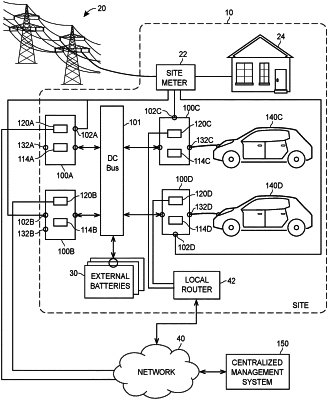| CPC H02J 3/144 (2020.01) [B60L 53/14 (2019.02); H02J 3/0075 (2020.01)] | 20 Claims |

|
1. A vehicle charging system for charging a vehicle, comprising:
one or more alternating current (AC) power ports configured to receive input electric power from an AC power source and to provide output electric power from the vehicle charging system to a local AC circuit at a charging site, wherein the local AC circuit connects the vehicle charging system to an additional AC power port of an additional vehicle charging system at the charging site;
a battery configured to receive and store direct current (DC) electric power derived from the input electric power;
a bidirectional inverter disposed between the one or more AC power ports and the battery, the bidirectional inverter being configured to convert AC power from the one or more AC power ports into DC power to charge the battery and to convert DC power from the battery into AC power to be supplied from the vehicle charging system to the one or more AC power ports;
a vehicle coupling configured to receive a charging current from the battery and to provide an electrical interconnect between the vehicle charging system and the vehicle in order to provide the charging current to the vehicle; and
a system controller comprising one or more processors configured to:
determine occurrence of a triggering condition for charge transfer between the battery of the vehicle charging system and an additional battery of the additional vehicle charging system via the local AC circuit; and
in response to determining occurrence of the triggering condition, control the bidirectional inverter to effect the charge transfer based upon the triggering condition by either (i) converting a DC output power from the battery into an AC output power to the one or more AC power ports to provide the AC output power to the local AC circuit or (ii) converting an AC input power received from the local AC circuit via the one or more AC power ports into a DC input power to charge the battery.
|